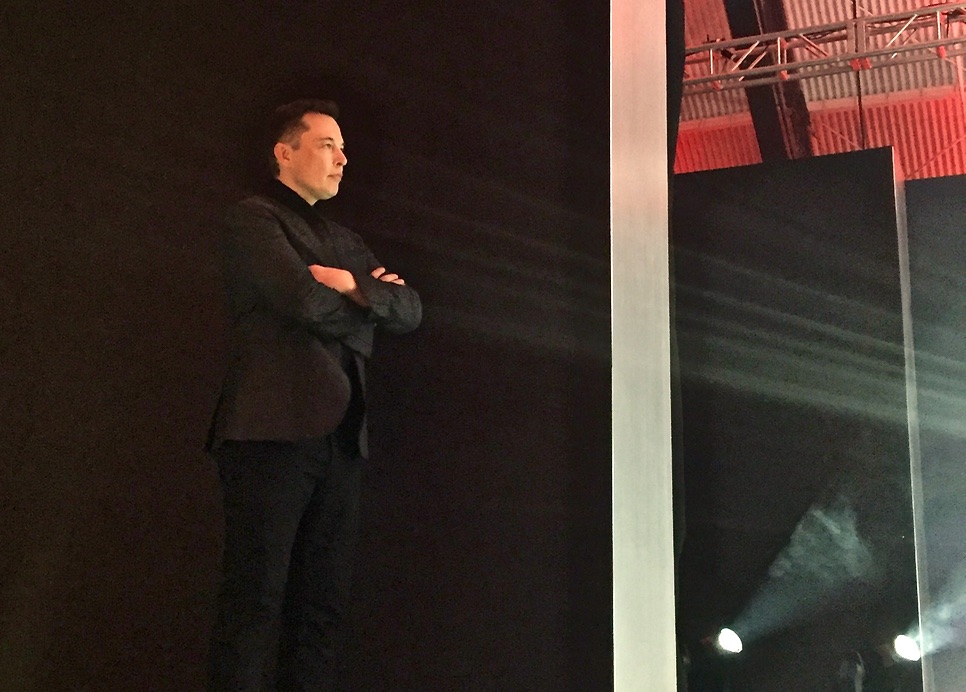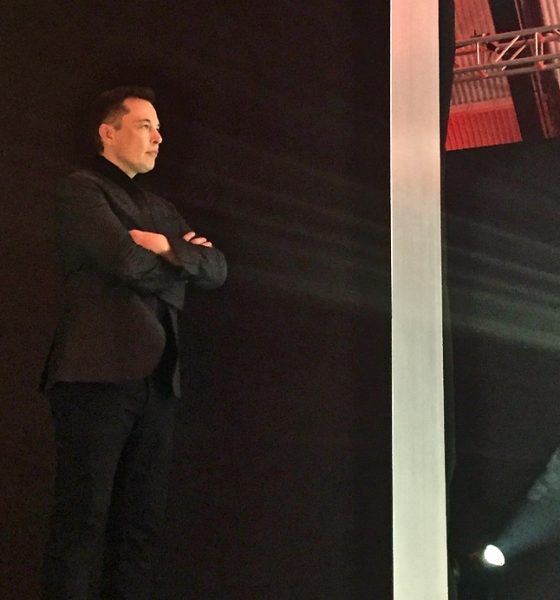

News
Tesla (TSLA) stock falls on report of alleged Department of Justice criminal probe
Shares of Tesla (NASDAQ:TSLA) fell by more than 5% in midday trading Tuesday following a report that the Silicon Valley electric carmaker is under investigation by the US Justice Department over statements made by company CEO Elon Musk last month pertaining to the company’s possible privatization and the fact that funding had been “secured.”
News of the Justice Department’s investigation was related to Bloomberg News by two individuals familiar with the matter. The criminal investigation will reportedly run alongside a previously reported civil inquiry by the Securities and Exchange Commission (SEC). The criminal investigation is reportedly in its early stages.
Federal prosecutors reportedly opened the fraud investigation due to Elon Musk’s now-infamous “funding secured” tweet last August 9, which resulted in TSLA stock soaring 11% to $387.46, according to the publication’s sources. Inasmuch as the announcement pushed the company’s stock near its all-time highs on the day of Musk’s tweet, TSLA stock began a long trek down as questions emerged about the source of funding the CEO was referring to in his tweet.
Few details are currently known about the ongoing investigation. That being said, Justice Department probes like the civil inquiries being undertaken by the SEC, are known to take months to complete, with investigations at times ending with prosecutors deciding to take no enforcement action.
A few days after announcing that he is thinking of taking Tesla private, Elon Musk published a blog post stating that the “funding secured” tweet came from talks he has had with Saudi Arabia’s sovereign wealth fund, which took a 5% stake in Tesla earlier this year. The weeks following these announcements were incredibly volatile, as SEC investigations were reportedly begun, lawsuits were filed, and TSLA shares took a dive.
Tesla, for its part, began the process for its possible privatization. Musk hired several high-profile advisers including bankers from Goldman Sachs, as well as attorneys from Wachtell, Lipton, Rosen & Katz. He also hired Silver Lake Partners’ Egon Durban, who brokered and helped bankroll the buyout of Dell when it went private. By August 22, Tesla’s advisers had a list of possible investors that would provide funding for the company’s privatization at $420 per share.
Among the investors that were willing to fund Elon Musk’s go-private initiative were German auto giant Volkswagen AG, as well as Silver Lake Partners itself. Together, the investors reportedly agreed to contribute as much as $30 billion for the deal. At this point, though, Elon Musk already had reservations, particularly since it would be incredibly difficult to bring over TSLA’s retail investors into a privatized Tesla.
Ultimately, Elon Musk opted to walk out of a possible $30 billion deal. An announcement about the company staying public was posted on Tesla’s official blog soon after. Since then, Tesla has focused itself on its original Q3 2018 targets — that is, the continued production ramp of the Model 3 and the company’s aim to become profitable. The company appears poised towards a record quarter, particularly after Elon Musk noted in a letter to employees that Tesla is “about to have the most amazing quarter in (its) history, building and delivering more than twice as many cars as (it) did last quarter.”
Following is Tesla’s official response to the reported DOJ investigation.
“Last month, following Elon’s announcement that he was considering taking the company private, Tesla received a voluntary request for documents from the DOJ and has been cooperative in responding to it. We have not received a subpoena, a request for testimony, or any other formal process. We respect the DOJ’s desire to get information about this and believe that the matter should be quickly resolved as they review the information they have received.”
As of writing, Tesla stock is trading down 2.22% at $288.27 per share.
This story is currently developing.

News
Tesla FSD fleet is nearing 7 billion total miles, including 2.5 billion city miles
As can be seen on Tesla’s official FSD webpage, vehicles equipped with the system have now navigated over 6.99 billion miles.

Tesla’s Full Self-Driving (Supervised) fleet is closing in on almost 7 billion total miles driven, as per data posted by the company on its official FSD webpage.
These figures hint at the massive scale of data fueling Tesla’s rapid FSD improvements, which have been quite notable as of late.
FSD mileage milestones
As can be seen on Tesla’s official FSD webpage, vehicles equipped with the system have now navigated over 6.99 billion miles. Tesla owner and avid FSD tester Whole Mars Catalog also shared a screenshot indicating that from the nearly 7 billion miles traveled by the FSD fleet, more than 2.5 billion miles were driven inside cities.
City miles are particularly valuable for complex urban scenarios like unprotected turns, pedestrian interactions, and traffic lights. This is also the difference-maker for FSD, as only complex solutions, such as Waymo’s self-driving taxis, operate similarly on inner-city streets. And even then, incidents such as the San Francisco blackouts have proven challenging for sensor-rich vehicles like Waymos.
Tesla’s data edge
Tesla has a number of advantages in the autonomous vehicle sector, one of which is the size of its fleet and the number of vehicles training FSD on real-world roads. Tesla’s nearly 7 billion FSD miles then allow the company to roll out updates that make its vehicles behave like they are being driven by experienced drivers, even if they are operating on their own.
So notable are Tesla’s improvements to FSD that NVIDIA Director of Robotics Jim Fan, after experiencing FSD v14, noted that the system is the first AI that passes what he described as a “Physical Turing Test.”
“Despite knowing exactly how robot learning works, I still find it magical watching the steering wheel turn by itself. First it feels surreal, next it becomes routine. Then, like the smartphone, taking it away actively hurts. This is how humanity gets rewired and glued to god-like technologies,” Fan wrote in a post on X.
News
Tesla starts showing how FSD will change lives in Europe
Local officials tested the system on narrow country roads and were impressed by FSD’s smooth, human-like driving, with some calling the service a game-changer for everyday life in areas that are far from urban centers.

Tesla has launched Europe’s first public shuttle service using Full Self-Driving (Supervised) in the rural Eifelkreis Bitburg-Prüm region of Germany, demonstrating how the technology can restore independence and mobility for people who struggle with limited transport options.
Local officials tested the system on narrow country roads and were impressed by FSD’s smooth, human-like driving, with some calling the service a game-changer for everyday life in areas that are far from urban centers.
Officials see real impact on rural residents
Arzfeld Mayor Johannes Kuhl and District Administrator Andreas Kruppert personally tested the Tesla shuttle service. This allowed them to see just how well FSD navigated winding lanes and rural roads confidently. Kruppert said, “Autonomous driving sounds like science fiction to many, but we simply see here that it works totally well in rural regions too.” Kuhl, for his part, also noted that FSD “feels like a very experienced driver.”
The pilot complements the area’s “Citizen Bus” program, which provides on-demand rides for elderly residents who can no longer drive themselves. Tesla Europe shared a video of a demonstration of the service, highlighting how FSD gives people their freedom back, even in places where public transport is not as prevalent.
What the Ministry for Economic Affairs and Transport says
Rhineland-Palatinate’s Minister Daniela Schmitt supported the project, praising the collaboration that made this “first of its kind in Europe” possible. As per the ministry, the rural rollout for the service shows FSD’s potential beyond major cities, and it delivers tangible benefits like grocery runs, doctor visits, and social connections for isolated residents.
“Reliable and flexible mobility is especially vital in rural areas. With the launch of a shuttle service using self-driving vehicles (FSD supervised) by Tesla in the Eifelkreis Bitburg-Prüm, an innovative pilot project is now getting underway that complements local community bus services. It is the first project of its kind in Europe.
“The result is a real gain for rural mobility: greater accessibility, more flexibility and tangible benefits for everyday life. A strong signal for innovation, cooperation and future-oriented mobility beyond urban centers,” the ministry wrote in a LinkedIn post.
News
Tesla China quietly posts Robotaxi-related job listing
Tesla China is currently seeking a Low Voltage Electrical Engineer to work on circuit board design for the company’s autonomous vehicles.

Tesla has posted a new job listing in Shanghai explicitly tied to its Robotaxi program, fueling speculation that the company is preparing to launch its dedicated autonomous ride-hailing service in China.
As noted in the listing, Tesla China is currently seeking a Low Voltage Electrical Engineer to work on circuit board design for the company’s autonomous vehicles.
Robotaxi-specific role
The listing, which was shared on social media platform X by industry watcher @tslaming, suggested that Tesla China is looking to fill the role urgently. The job listing itself specifically mentions that the person hired for the role will be working on the Low Voltage Hardware team, which would design the circuit boards that would serve as the nervous system of the Robotaxi.
Key tasks for the role, as indicated in the job listing, include collaboration with PCB layout, firmware, mechanical, program management, and validation teams, among other responsibilities. The role is based in Shanghai.
China Robotaxi launch
China represents a massive potential market for robotaxis, with its dense urban centers and supportive policies in select cities. Tesla has limited permission to roll out FSD in the country, though despite this, its vehicles have been hailed as among the best in the market when it comes to autonomous features. So far, at least, it appears that China supports Tesla’s FSD and Robotaxi rollout.
This was hinted at in November, when Tesla brought the Cybercab to the 8th China International Import Expo (CIIE) in Shanghai, marking the first time that the autonomous two-seater was brought to the Asia-Pacific region. The vehicle, despite not having a release date in China, received a significant amount of interest among the event’s attendees.








